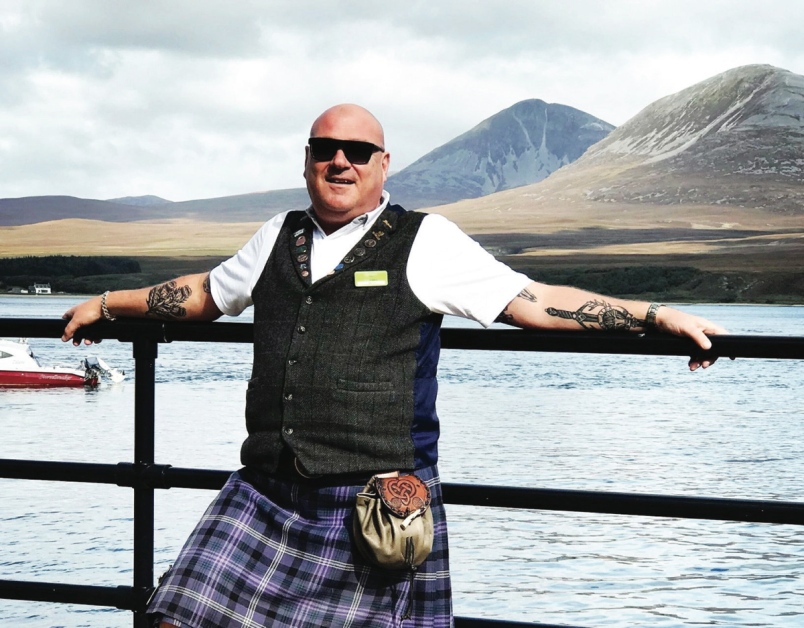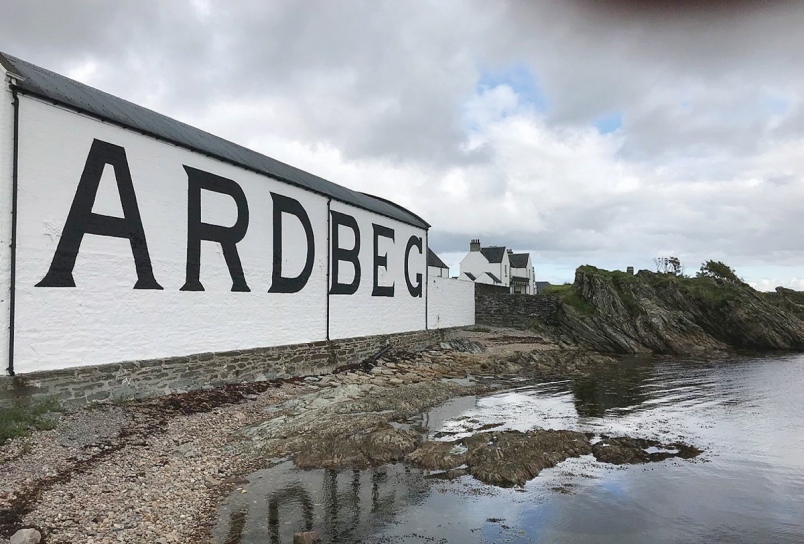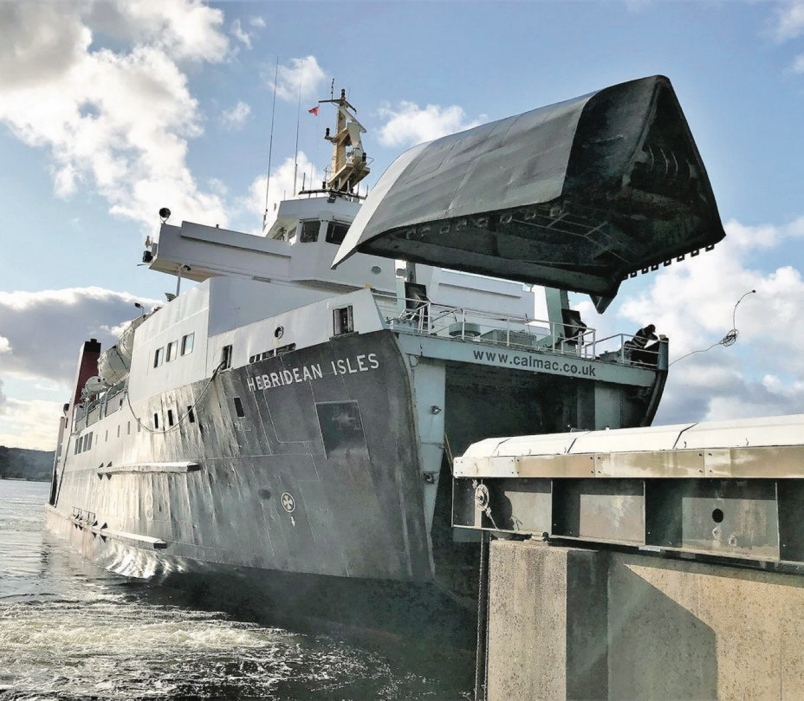Pilgrimage to Southern Hebrides island captures spirit of single-malt whisky

The following article originally appeared in the April 27th edition of the Times Colonist.
My husband loves his whisky. The 16 bottles in his current stock bear the names of such distilleries as Laphroaig, Lagavulin, Bowmore, Ardbeg and Bruichladdich — all from the Scottish Isle of Islay (pronounced EYE-la), renowned for its strong, peaty, single-malt whisky.
He opens a bottle, takes a whiff and pronounces it “nectar of the Gods.” To me, it smells more like a medicinal solution best left to the operating room. I’ve seen the flavour described as a “campfire in your mouth” and “rubber, wood, fire, dirt and leather — but in a great way.” Praise like that might explain why Islay whisky is known as the Marmite of Scotch.
“You either love it or you hate it,” said Graeme Littlejohn, deputy director at the Scotch Whisky Association of Scotland. “There are Scotches that are produced on the island which have a very highly peated quality, very smoky whiskies. There are some whiskies on the island — like Laphroaig, like Lagavulin — that people will try for the first time and they will never drink anything else, that will be their drink for life because they love the peated quality of it.”
So for love of the guy who loves his Islay whiskies, a late summer visit to Scotland would require a visit to the southernmost island of the Inner Southern Hebrides.

Nine distilleries make their spirits on this island that stretches just 40 kilometres long and 24 km wide, just a bit smaller in size than Greater Victoria’s 13 municipalities. But, with only 3,228 residents, it’s home to less than 1/100th of our region’s population. Driving around Islay, you see a lot of wide open fields dotted with cows and sheep. And a lot of peat bogs — a spongy wetland with few trees and shifting ground that makes for some bumpy roads.
It’s the peat, lashed by sea spray during frequent Atlantic storms, that gives Islay whiskies their distinctive taste and aroma. That and the sea water, which is why the distilleries are sited along the shoreline.
By British law, whisky cannot be sold until it has been aged for three years. The basic process for making single-malt Scotch follows five steps: malting barley by steeping it in water and then drying the malt in a kiln (which, on Islay, usually means burning peat), mashing the grist and mixing it with hot water to create a sugary liquid known as wort (with the remaining solids used for cattle feed), fermenting the wort in large vats to create “wash” (which tastes like beer), distilling it in pot and spirit stills, then maturing it in oak casks. However, no two distilleries do this exactly same way. That’s what each company likes to show off during its distillery tours.
Pilgrimages to Scotland’s 128 whisky distilleries set a record in 2017: 1.9 million visits by tourists from all over the world. The eight distilleries on Islay that year — one more has opened since — saw 150,000 visits.
“This is an industry that is 500 years old and it began exporting from Scotland to countries around the world in the mid-19th century,” Littlejohn said.
“It has really developed since then from a primarily domestic spirit to one that is exported to 180 countries.”
Lots of distilleries are investing in tourism, adding welcome centres and cafés, offering a variety of tours and tastings, even producing less time-consuming spirits — anything that promotes whisky and helps distilleries fill the financial gap while whisky is maturing for as long as 20 years or more, Littlejohn said.
For tourists who arrive by car — like the German fellow we met at one distillery who was making his annual Scotch restocking tour of Islay — distilleries provide tiny glass jars (known as “driving drams”) so you can take away your whisky tastings to enjoy later.

You can walk to some of the distilleries. In fact, Lagavulin, Ardbeg and Laphroaig are close enough together that they’ve built a 5.5-km path, accessible for walkers, cyclists and wheelchairs, between Port Ellen and the distilleries.
That means you can set your own schedule and drink all you want before stumbling back to your starting point. You can also hire a taxi to get around.
We booked from Canada one of many tours that prearranges transportation, tours and accommodation. We joined 12 other pilgrims — two Canadians, two Americans, four New Zealanders and four Icelanders — on a comfy, 16-passenger mini-bus.
Our bus driver, Moray Walker, looked like he’d been sent by central casting — tall, bald, built like a rugby player, clad in a vest and kilt, sporting tattoos that included the thistle emblem of Scotland, a Celtic sword, skulls and roses.
His accent was as thick and deep as a full-bodied whisky. He likes to say that he took up guiding tours after getting out of jail. He was a prison guard for 25 years.
On Islay, we stayed at Bowmore House, a five-bedroom bed and breakfast, named after the small town’s capital.
When it’s overbooked, as it was when we were there, some guests stay next door in an Air Bnb-style apartment with three bedrooms, a living room and kitchen.
Andrew Jackson, who has owned and operated the BnB with his wife Alison for about eight years, used to work as a criminal lawyer in England’s Lake District. He came to Islay to visit his favourite distillery — Laphroaig — and fell in love with the place.
As well as supporting some of the world’s best distilleries, the island is beautiful, he said. “The beaches, the nature — nothing compared to Canada in the sense of size — but you’ve got a bit of everything here, the mountains, the rivers, the lakes, the beaches. Everything is on your doorstep.”
The hearty breakfast at Bowmore House, like most in Scotland, includes haggis and blood pudding, but Jackson also offers up a dram from his selection of Islay whiskies.
My husband estimates that, given the number of tastings at each distillery, we were offered close to 600 ml of Scotch over two days. That doesn’t include the whisky available at breakfast in our guest house and on the menu almost everywhere at lunch and dinner. And it doesn’t count the several drams of gin we drank at Bruichladdich, where locally foraged botanicals are added to berries, barks, seeds and peels, distilled in spirit and Islay spring water, and then bottled under the Botanist label. Since it takes barely weeks to make gin, selling it helps top up the coffers while waiting years for the whisky to mature, the distillery guide noted.
For aficionados, whisky tours offer a peek into the magic process that creates the spirit they love. Islay is especially appealing because of the unique history and tastings at the distilleries, said Páll Svavar Pálsson, an engineer, who joined our tour with three friends from his whisky club in Iceland.
While tasting the range of whiskies is fun, it is a special thrill to fill your own bottle from a cask, as Pálsson did at Bunnahabhain.
At each of the seven distilleries we visited, knowledgeable, enthusiastic guides made the tours engaging, especially at Lagavulin. That visit isn’t so much a tour as an audience with the legendary Iain McArthur. He has worked in the distillery for 48 years, most of that time in a warehouse full of casks like the one we were ushered into. His grandfather and uncle also worked there while other family members worked at other island distilleries — the “family business” for his and many others on Islay where the whisky industry is the main employer. McArthur talked about the history of the distillery — founded in 1816, though distilling on the site is said to date back to the mid-1700s — and the process of making whisky.
He asked if we’ve heard of the “angel share.” In the process of making whisky, two per cent of the volume is lost to evaporation every year for up to about 10 years, though every cask is different. The excitement began when McArthur dipped a large metal cylinder into a cask that held the last measure of whisky from this year’s limited-edition release for the Islay Jazz Festival, held every September. More tastings followed from casks of six-, 16-, 20-, 21- and a 25-year-old vintages.
At Lagavulin — as well as Ardbeg, Laphroaig and Kilchoman — we got to keep the small tasting glasses etched with the distillery’s name. Laphroaig’s glasses hang from a lanyard, presumably to keep your hands free to check out the merchandise in its well-stocked shop. The other distilleries packed the glass souvenirs in small boxes. All the distilleries have shops that sell more than just bottles of whisky.
While the Scots might not be known for their cuisine, we’d heard about the great food in the Ardbeg distillery’s café. A giant copper still, sitting on a raised platform, greets visitors to Ardbeg. Founded in 1815, it was once the largest whisky producer on Islay, but closed and changed hands numerous times. It was pulled out of mothballs in 1997, opened a visitor centre and café and was voted distillery of the year in 1998. The Old Kiln Café — in the original 1815 kiln room — serves tasty sandwiches, paninis and toasties, all with crisp, fresh salad, for between £4.50 to £5.95. Hearty meals — fish pie, steak pie, cheesy macaroni or haggis, neeps and tatties — are priced from £9.95 to £11.95.
There’s also a lovely café in the Kilchoman distillery, where you can get a very fine bowl of Cullen skink, a thick Scottish soup made with smoked haddock, potatoes and onions for £6.50. Known as Islay’s farm distillery, Kilchoman opened in 2005, but recently lost its title as the island’s newest distillery after Ardnahoe opened in late 2018. Currently the smallest Islay distillery, Kilchoman is building a new stillhouse, mash house and tun room, which will double its production to 460,000 litres per year. It’s the only distillery that does everything — from growing its barley to bottling the whisky — on Islay.
Kilchoman, Bowmore and Laphroaig are among the few whisky distilleries that still use malting floors instead of germination boxes or drums. Once grain has been steeped, it is spread evenly by hand into a thick layer on a stone floor where it is turned at least twice a day, every day, to keep it oxygenated and to dissipate heat.
My favourite stop — and the only place I managed to down all three drams of whisky offered — featured the most dramatic setting, looking across the Sound of Islay to the mountains on the Isle of Jura. And it almost didn’t happen. Our driver offered the special tasting at the Caol Ila (pronounced cull-eela) distillery as an option, but it’s hosted outdoors on a picnic table, so depended on good weather. The skies seemed threatening in the morning, but cleared just in time for our visit.
The melt-in-your-mouth handmade chocolate paired incredibly well with the whisky. Mind you, Caol Ila produces one of the Island’s lighter whiskies, often used in blended varieties. In the sunshine, sipping whisky, savouring fine chocolate and soaking in the setting, it seemed that a whisky tour was a fine way to enjoy the spirit of Scotland.

IF YOU GO:
Getting there:
You can fly directly to the island’s airport from Glasgow or take the ferry from Kennacraig, about 2 1/2 hours from Glasgow. The ferry crosses to Islay in two hours, if you’re going to Port Askaig in the north, or two hours and 20 minutes going to Port Ellen in the south. The 507-passenger, 68-car MV Hebridean Isles will feel familiar to anyone who has travelled to or from Vancouver Island by ferry. To get around to the distilleries, you can drive across on the ferry or bring your bike, because the island is mostly flat.
Whisky tours: We travelled with Scottish Routes (scottishroutes.com). A four-day bus tour to Islay, starting from either Glasgow or Edinburgh, is £650 or about $1,110, including transportation, bed and breakfast, and tours with tastings at up to seven distilleries. Lots of other tours are available. Check that they include fees for entry and tasting at distilleries. You can also plan your own itinerary by booking with individual distilleries and hiring taxis to get around.

